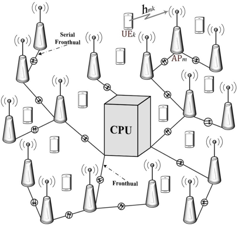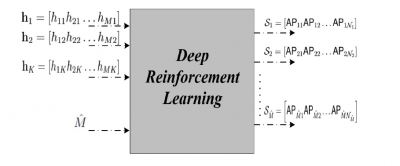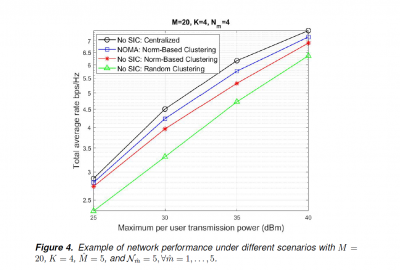Yasser Al-Eryani and Ekram Hossain
Published: 13 Nov 2019
Abstract
The next generation of wireless networks will have to serve a massive number of users within small geographical areas, and this will give rise to dense/ultra-dense deployment of access points (APs)/base stations (BSs) with overlapping coverage areas. In such a scenario, devices will be served simultaneously by multiple APs/BSs (e.g. through multi-point user associations and multi-point transmis- sions) for efficient hand-off, frequency allocation and interference management. This article proposes the use of a dynamically changing cell-less wireless network architecture that copes with the high complexity of a fully-centralized cell-less architecture in an ultra-dense network deployment scenario. It also discusses the use of artificial intelligence (AI)-based methods to form clusters of APs efficiently as well as non-orthogonal multiple access (NOMA) to satisfy the massive wireless connectivity requirement.
Keywords: Beyond 5G networks, cell-less (or cell-free) architectures, non-orthogonal multiple access, artificial intelligence and machine learning.
1. Introduction
With the huge increase in the number of electronic devices per unit area that will require simultaneous wireless connectivity in future wireless networks, the problems of spectrum scarcity, power efficiency and signal interference will reach a new height. These problems will need to be efficiently tackled in order to avoid serious service degradation [1–4]. In this regard, with the full-utilization of the radio spectrum (from AM up to mmWaves and visible light frequency bands), pure orthogonal multiple access schemes will not be enough to tackle the problem of spectrum scarcity. Accordingly, the concept of non-orthogonal multiple access scheme (NOMA), in which multi-users are encoded in the power domain instead of time/frequency domains [5–7], has attracted a lot of attention. On the other hand, completely non-orthogonal multiple access introduces an additional interference component (i.e. inter-user interference) that may affect the reliability of many critical wireless communication services.
Generally speaking, tackling the problem of interference through conventional interference mitigation techniques such as users’ scheduling and power allocation become extremely complicated, especially when massive numbers of wireless devices are distributed within a small geographical area. This has motivated the introduction of access point (AP)/base station (BS) coordination that is supported by extremely fast fronthauling techniques and central processing units (such as in
cloud radio access networks [C-RAN] and cell-less network architectures). Nevertheless, central processing of a massive amount of data poses huge computational challenges and delay limitations that contradict with the need for low-complexity and ultra-low latency communications in future wireless networks. This calls for the need for more sophisticated wireless network architectures and multiple access schemes in future wireless networks.
2. Centralized Cell-Less Architecture
The large amount of interference due to massive wireless connectivity has urged researchers and network designers to migrate from non-cognitive interference mitigation techniques (such as point-to-point multiple antenna schemes that enhance the signal-to-interference-plus-noise ratio (SINR) of a certain wireless receiver by sending multiple copies of its signal simultaneously and ignore interference caused by other BSs) to cognitive interference management techniques in which the SINR of different receivers are enhanced by both increasing the amount of the desired signal and decreasing interference levels. This has opened the door for comprehensive and simultaneous coordination among wireless transmitters and receivers. User coordination and cooperation can be achieved by connecting all APs within a certain geographical area to each other through extremely high-speed fronthualing links (as shown in Fig. 1).

In this communication setup, all APs are connected to each other to form a cell-less network architecture that enables the APs to jointly collaborate to simultaneously serve all terminal devices within their coverage area [8]. The processing of users’ signals (either encoding or decoding) is conducted at a central processing unit (CPU) pool that performs the last-stage processing tasks to decode(encode) signals from(to) wireless transmitters(receivers).
As an example, the SINR of the received signal from the k-th user at the CPU

3. Dynamic Cell-Less Architecture
To tackle the issues of fronthauling overhead and high complexity of massive cellless networks, some recent works have proposed signal processing schemes that distribute the pre-processing and detection functionalities among CPU pools and APs while maintaining a static property of the network by assigning identical tasks to all APs (i.e. all APs are selected to take part in the processing of signal detection in an identical manner). This can be referred to as multi-level AP cooperation and can be achieved through different signal processing schemes (maximal ratio combining [MRC], minimum mean square error [MMSE], zero forcing beam-forming [ZFBF], etc.) [9]. Such a distribution of tasks between CPU Pools and APs will result in a trade-off between performance and system complexity. Building on top of the above concept, we propose a dynamically changing cellless architecture that can significantly decrease the amount of fronthualing overhead and central processing by updating the allocation of tasks among the APs according to the instantaneous channel state information (CSI) of the network. The idea of the proposed scheme is that the set of serving APs is dynamically partitioned into subsets of APs clustered based on the current CSI of the network (see Fig. 2). Furthermore, all APs of a certain subset act as a virtual collocated transmitter(receiver) diversity (V-TRD) system [10, 11]. Therefore, the CPU will deal with every subset as a single virtual AP with multiple antennas. Due to the decrease in the number of real APs directly connected to the CPU pool, this will reduce the fronthauling overhead and optimization variables significantly. Specifically, compared with (1), the SINR for the k-th user at the CPU detector unit can


comes complicated and time consuming. Additionally, when the number of sub-sets becomes small, performance degradation compared to the fully centralized networks can increase significantly. Note that a small number of subsets means that most of the APs will be used as antennas for the VTR-Diversity system. The maximum number of subsets may be equal to the total number of APs in the net-work such that every subset contains only one AP. This scenario is identical to the fully-centralized network scenario. The CPU deals with every subset as a sin-gle virtual AP with multiple antennas. Therefore, processing is more distributed, especially when the number of APs per set is large (i.e. the number of AP sets is small). In such a scenario, the CPU will have a fewer degrees of freedom in optimizing the performance (i.e. shorter encoding/precoding vector length). As an example, if we have only two subsets, all of the APs will be allocated between those two sets. The CPU then will have to control only a weighted sum of two signals coming from these two subsets. However, if we have four subsets, the CPU will have more degree of freedom since it will optimize a weighted sum of four signals rather than only two in the previous case.
In the following two subsections, we first discuss how clustering can be done based on some intelligence(AI)-based technique. Furthermore, we also propose the utilization of NOMA scheme to improve spectral efficiency of the network.
3.1.AP Clustering
The process of partitioning APs into different subsets can be modeled as an opti-mization problem that allocates the APs among a predetermined number of sub-sets(the number of subsets is selected based on factors such as the required reduction level of complexity, fronthauling overhead, and/or delay). However, solv-ing such an optimization problem may be very complicated and time consuming, especially for massive numbers of APs and/or terminal users. This can be tack-led by investigating a group of sub-optimal clustering algorithms that can be easily solved with minimum possible delay. One example of these algorithms is to assign equal number of APs to every subset and allocating every subset with a group of APs that have the maximum norm with any arbitrary terminal user. This strategy may be considered as a simplified MRC scheme that focuses on enhancing the user’s signal related to the best channel gain with a certain subset. Usually, for distributed MIMO systems, the receiver first uses MRC technique as the first step of decoding an intended signal. This is achieved by multiplying the received signal from every AP by the complex conjugate of the channel gain between the signal coming from the intended user and that AP. In the proposed scheme, we multiply the overall signal of every subset (the sum of received signals from all APs at a certain subset) by the complex conjugate of the sum of channel gains of the intended user and all APs of that subset. The performance of such an allocation algorithm can be very poor compared to that of the optimal one.
To overcome the complexity of exhaustive search-based optimal clustering, ar-tificial intelligence (AI)-based methods can be developed to obtain an efficient allocation of APs among different subsets (in terms of maximizing the average per user SINR). Fig. 3 shows the block diagram of such an AI-based approach (which uses deep reinforcement learning in particular) that accepts the channel gain matrix (denoted by H), number of subsets of APs, and the number of APs per each subset, and returns an assignment of every AP in the network to a certain subset.
3.2.NOMA-Enabled Dynamic Cell-Less Architecture
We have showed in previous sections how moving from fully-centralized cell-less architectures into dynamic cell-less networks with partially distributed processing significantly decreases the system complexity and delay. However, such a design can result in a degradation of network performance as the number of AP subsets and/or the number of terminal users decreases. To compensate for this perfor-mance degradation, we propose the use of NOMA scheme among all terminal users under full cooperation among APs [1]. Accordingly, assuming that all termi-nal users are ordered in a descending ordering, the SINR of the k-th user at the

input of the CPU pool can be rewritten differently from (2) as

Note that the interference contribution of the k − 1 users with higher overall channel gain is removed through successive interference cancellation (SIC). This will boost up the average per user performance by removing interference from users with stronger channel gain. Fig. 4 illustrates the performance of different schemes.
In this figure, “No SIC” refers to a system similar to multi-user MIMO systems in which all users use the same frequency and interference from to a user from other users is minimized through precoding/encoding process; however, no SIC is used. Norm-based clustering is the method of allocating APs based on the maximum norm of users as briefly discussed in 3.1. Random clustering is the process of randomly allocating APs among subsets.
4. Conclusion
A new paradigm of cell-less wireless network to be used for future ultra-dense network with massive number of wireless devices has been investigated. All of the APs of a cell-less network are assumed to be dynamically divided into sub-sets at which every subset form a virtual transmit(receive) diversity system. The proposed scheme can be achieved either optimally by solving an optimization problem that assign APs among different subsets or sub-optimally using some al-gorithms that utilizes transmit(receive) diversity schemes on allocating APs such that the average performance is maximized. We have proposed the use of AI-based technique for clustering APs as well as NOMA schemes for efficient net-work performance. The design of efficient and low complexity systems that jointly allocate access points among subsets and at the same time optimize precod-ing(decoding) vectors as well as transmission power values remains an interest-ing future research area. Additionally, dynamic network clustering can consider channel state information as well as type of service.

References
[1] Y. Al-Eryani, E. Hossain, and D. I. Kim, “Generalized coordinated multipoint (GCoMP)-enabled noma: Outage, capacity, and power allocation,” IEEE Trans. on Commun., pp. 1–1, 2019.
[2] A. Zanella, N. Bui, A. Castellani, L. Vangelista, and M. Zorzi, “Internet of things for smart cities,” IEEE Internet of Things J., vol. 1, no. 1, pp. 22–32, Feb. 2014.
[3] Y. Al-Eryani and E. Hossain, “The D-OMA method for massive multiple ac-cess in 6G: Performance, security, and challenges,” IEEE Mag. on Veh. Tech-nol., vol. 14, no. 3, pp. 92–99, Sep. 2019.
[4] K. David and H. Berndt, “6G vision and requirements: Is there any need for beyond 5g?” IEEE Veh. Technol. Mag., vol. 13, no. 3, pp. 72–80, Sep. 2018.
[5] P. Wang, J. Xiao, and L. P, “Comparison of orthogonal and non-orthogonal approaches to future wireless cellular systems,” vol. 1, no. 3, pp. 4–11, Sep. 2006.
[6] Y. Cai, Z. Qin, F. Cui, G. Y. Li, and J. A. McCann, “Modulation and multiple access for 5G networks,” vol. 20, no. 1, pp. 629–646, Firstquarter 2018.
[7] R16-38812, “Technical specification group radio access network: Study on non-orthogonal multiple access (NOMA) for NR,” in 3GPP Technical Report, Nov. 2018.
[8] S. Zhou, M. Zhao, X. Xu, J. Wang, and Y. Yao, “Distributed wireless commu-nication system: a new architecture for future public wireless access,” IEEE Mag. Commun., vol. 41, no. 3, pp. 108–113, March 2003.
[9] E. Bj¨ornson and L. Sanguinetti, “Making cell-free massive MIMO competitive with MMSE processing and centralized implementation,” CoRR, vol. abs/1903.10611, 2019. [Online]. Available: http://arxiv.org/abs/1903.10611
[10] E. Villier, “Performance analysis of optimum combining with multiple inter-ferers in flat rayleigh fading,” IEEE Trans. on Commun., vol. 47, no. 10, pp. 1503–1510, Oct. 1999.
[11] P. J. Smith, “Exact performance analysis of optimum combining with multiple interferers in flat rayleigh fading,” IEEE Trans. on Commun., vol. 55, no. 9, pp. 1674–1677, Sep. 2007.
Authors




